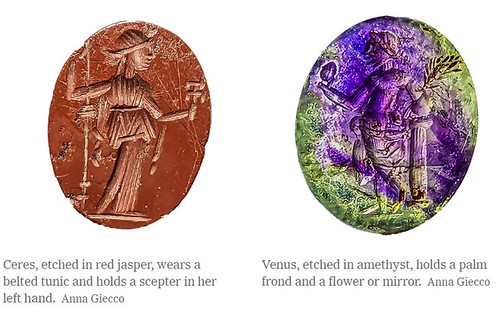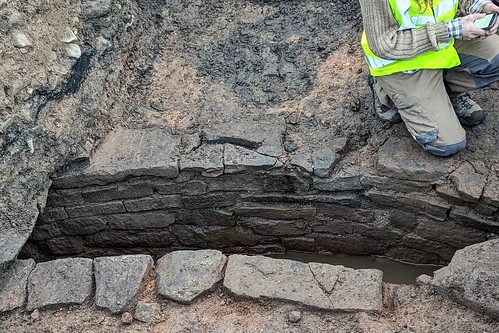
PREV ARTICLE
NEXT ARTICLE
FULL ISSUE
PREV FULL ISSUE
ENGRAVED STONES FOUND IN ROMAN BATHHOUSEPaul Horner writes: "Not exactly coins, but these Roman intaglios found in England are still pretty and interesting." Indeed - very nice work. -Editor Nowadays, you likely secure your valuable jewelry before a trip to the spa. But ancient Romans may not have taken that extra step before enjoying a hot bath.
Recently, archaeologists in Britain discovered dozens of engraved semiprecious stones from the third century at the site of an ancient bathhouse beneath the Carlisle Cricket Club, The New York Times reported. Smaller than a dime, the 36 gems are made of materials like amethyst, carnelian, and jasper. Called
The bathhouse, located near Hadrian's Wall in Carlisle, England, was apparently a massive structure. During a visit, ancient Romans would have first popped into the apodyterium, or changing room, where they would have removed all of their clothing except for their bath sandals, to protect their feet from the heated floors. Some would have slaves or the bathhouse attendants look over their belongings, but others kept their jewelry on to prevent theft.
While that seems smart in theory, the water may have loosened the adhesives used in the rings—like birch bark resin—and caused the metal settings to expand and contract. So the stones probably just fell off, sinking to the bottom of the baths and ending up in the drains when the pools and saunas were cleaned.
To read the complete article, see:
Here's more from the original NYT piece, with the great headline of "Ancient Romans Dropped Their Bling Down the Drain, Too." -Editor Down the drain is where British archaeologists recently discovered 36 artfully engraved semiprecious stones, in an ancient bathhouse at the site of a Roman fort near Hadrian's Wall in Carlisle, England. The colorful intaglios — gems with incised carvings — likely fell out of signet rings worn by wealthy third-century bathers, and ended up trapped in the stone drains. The delicate intaglios, fashioned from amethyst, jasper and carnelian, range in diameter from 5 millimeters to 16 millimeters — bigger than a pencil eraser, smaller than a dime. Some bear images of Apollo, Mars, Bonus Eventus and other Roman deities symbolizing war or good fortune. Others showcase Ceres, the god of fertility, Sol (the sun) and Mercury (commerce). One amethyst depicts Venus holding either a flower or a mirror. A reddish-brown jasper features a satyr seated on rocks beside a pillar. Historically, two kinds of engraved gems were worn mounted on finger rings: intaglios, which have designs cut as a depression into the surface of the gem; and cameos, with designs that project from the background, a raised image in relief. The tradition of intaglios goes back to the Sumerian period in Mesopotamia, where figures were gouged by hand into softer stone. From about 3400 B.C., stamp seals and cylinder seals were pressed and imprinted into damp clay. These became popular in Minoan and Mycenaean Greece, Persia, Egypt and Rome, where they became objects of fashion; the statesman Cicero observed that people wore portraits of their favorite philosophers on their rings, a tradition that has not survived on today's QVC Network.
To read the complete article, see:
THE BOOK BAZARREWayne Homren, Editor The Numismatic Bibliomania Society is a non-profit organization promoting numismatic literature. See our web site at coinbooks.org. To submit items for publication in The E-Sylum, write to the Editor at this address: whomren@gmail.com To subscribe go to: https://my.binhost.com/lists/listinfo/esylum All Rights Reserved. NBS Home Page Contact the NBS webmaster 
|



